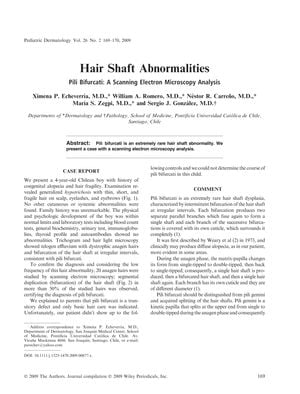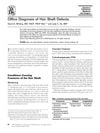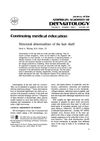Hair Shaft Abnormalities: Pili Bifurcati - A Scanning Electron Microscopy Analysis
March 2009
in “
Pediatric Dermatology
”

TLDR The study found that pili bifurcati causes hair to intermittently split into two branches, each with its own outer layer.
In the 2009 study, a rare case of pili bifurcati, a hair shaft abnormality, was presented involving a 4-year-old Chilean boy with congenital alopecia and hair fragility. The boy exhibited generalized hypotrichosis with thin, short, and fragile hair, but no other abnormalities were detected through various laboratory tests. A trichogram and light microscopy indicated telogen effluvium with dystrophic anagen hairs and irregular bifurcation of the hair shaft, consistent with pili bifurcati. To confirm the diagnosis, scanning electron microscopy (SEM) was performed on 20 anagen hairs, revealing segmental duplication in over 50% of the hairs. The study concluded that pili bifurcati is characterized by intermittent bifurcation of the hair shaft, with each branch having its own cuticle. It is distinct from other conditions like pili gemini and acquired splitting of the hair shafts. The study emphasized that SEM is a valuable tool for analyzing hair shaft abnormalities, although light microscopy can also diagnose most conditions, including pili bifurcati. The patient's follow-up was not possible, so the course of the condition remained undetermined.




